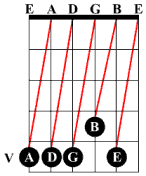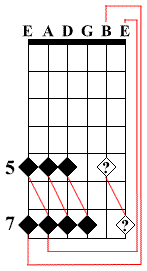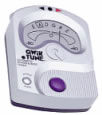
Three methods of tuning your guitar
- Relative Tuning
- Relative Tuning with Natural Harmonics
- Electronic Tuners
The Basics
From thickest to thinnest, the six strings on your guitar are tuned E, A, D, G, B and E. They can also be referred to by the number 1 through 6. With 1 being the thinnest string, and 6 being the thickest. This numbering of the strings helps in avoiding any confusion between the two E strings.
1. Relative Tuning
 With this method, you will be tuning the guitar so that it will sound in tune with itself. Your guitar will sound good when you play, but if your E string is not in tune you will not be tuned exactly to pitch.
With this method, you will be tuning the guitar so that it will sound in tune with itself. Your guitar will sound good when you play, but if your E string is not in tune you will not be tuned exactly to pitch.
The theory of Relative Tuning
- The note at the 5th fret on your E string is the same note as your open A string.
- The note at the 5th fret on your A string is the same note as your open D string.
- The note at the 5th fret on your D string is the same note as your open G string.
- The note at the 4th fret on your G string is the same note as your open B string.
- The note at the 5th fret on your B string is the same note as your open E string.
If you use your left hand to tune the string, you will have to remember what the note you are aiming for sounds like. You may find it easier to use your right hand to tune, as this will allow you to hear both notes at the same time. This will let you hear the "crashing" of the two notes against one another. As you get closer to being in tune the crashing will get further away, when it stops you are in tune.
Let's Do it
Play the note on the 6th string, 5th fret. Listen to the note, then try and tune the 5th string until it matches that pitch (A).
- Put your finger on the 5th fret on the E string. Tune the A string until both notes are the same.
- Put your finger on the 5th fret on the A string. Tune the D string until both notes are the same.
- Put your finger on the 5th fret on the D string. Tune the G string until both notes are the same.
- Put your finger on the 4th fret on the G string. Tune the B string until both notes are the same.
- Put your finger on the 5th fret on the B string. Tune the E string until both notes are the same.
2. Relative Tuning with Natural Harmonics
 As above, you will be tuning the guitar so that it will sound in tune with itself. Your guitar will sound good when you play, but if your E string is not in tune you will not be tuned exactly to pitch.
As above, you will be tuning the guitar so that it will sound in tune with itself. Your guitar will sound good when you play, but if your E string is not in tune you will not be tuned exactly to pitch.
To play a harmonic gently touch the string directly over the fret, not before it like we do when playing a chord, then gently pluck the string.
The theory of Relative Tuning with Natural Harmonics
- The 5th fret harmonic on your E string is the same as the 7th fret harmonic on your A string.
- The 5th fret harmonic on your A string is the same as the 7th fret harmonic on your D string.
- The 5th fret harmonic on your D string is the same as the 7th fret harmonic on your G string.
- The 7th fret harmonic on your E string is the same as the open B string.
- The 7th fret harmonic on your A string is the same as the open E string.
N.B. Because of the way that the guitar is tuned, you cannot not play the harmonic on the 5th fret of the G string to tune the B string.
Also, for the high E string, you could return to the method that you used on the bottom 4 strings i.e. play the 5th fret harmonic on the 2nd string, and use that to tune the 7th fret harmonic on the 1st string (marked with a ? on the diagram). These notes get pretty high, so they are a little bit harder to tune with, that's why we usually use the 7th fret harmonic on the A string to tune the high E string.
String |
5th Fret Harmonic |
7th Fret Harmonic |
12th Fret Harmonic |
E (6th) |
E (2 octaves higher) |
B |
E (octave higher) |
A (5th) | A (2 octaves higher) |
E |
A (octave higher) |
D (4th) |
D (2 octaves higher) |
A |
D (octave higher) |
G (3rd) |
G (2 octaves higher) |
D |
G (octave higher) |
B (2nd) |
B (2 octaves higher) |
F#/Gb |
B (octave higher) |
E (1st) |
E (2 octaves higher) |
B |
E (octave higher) |
N.B. The comments in parentheses are relative to the open string.
Let's Do It
- Play the 5th fret harmonic on the E string, then play the 7th fret harmonic on the A string. The trick is to make sure that both of the notes are ringing at the same time. Tune the A string until both notes are the same, you will hear the "crashing" as in the preivous method.
- Play the 5th fret harmonic on the A string, then play the 7th fret harmonic on the D string. Tune the D string until both notes are the same.
- Play the 5th fret harmonic on the D string, and the 7th fret harmonic on the G string. Tune the G string until both notes are the same.
- Play the 7th fret harmonic on the E string and tune the B string open to that.
- Play the 7th fret harmonic on the A string to tune the 1st string open.
3. Electronic Tuners
Tuning by ear takes some practice, so a good option for tuning your guitar when you are first starting out is to buy an electronic tuner.
I would suggest that you buy a digital tuner, with both a needle indication, and some some lights to tell you whether you are either too high (sharp) or too low (flat).
There are two types of electronic tuners that you can use for guitar. The first is one that allows you to tune all 6 strings to standard pitch. The other is a chromatic tuner, which will allow you to tune to any note, not just those in standard tuning. A lot of modern music requires that you tune down a semitone (1/2 step) or more, there are also many alternate tunings in use i.e drop D, open G, these tuning variations are much easier to achieve with a chromatic tuner. Chromatic tuners are also easier to use even if you are just tuning to standard pitch.
 There is one thing you must remember when using a standard guitar tuner. Unless the string that you are tuning is within a semitone (1/2 step) of the correct pitch, the tuner will not know what to tell you. For instance, if you are tuning your 6th string (low E) and it is tuned to an F (which is a 1/2 step to high), the needle will not register anything. To make matters worse the default position of the needle is to the left, so many people think that this automatically means that they are to low. Then they proceed to tune the string up, and up, until the string breaks. A standard guitar tuner is only good as a fine tuning tool, and unless you can tune by ear enough to get you within a 1/2 step, it is useless.
There is one thing you must remember when using a standard guitar tuner. Unless the string that you are tuning is within a semitone (1/2 step) of the correct pitch, the tuner will not know what to tell you. For instance, if you are tuning your 6th string (low E) and it is tuned to an F (which is a 1/2 step to high), the needle will not register anything. To make matters worse the default position of the needle is to the left, so many people think that this automatically means that they are to low. Then they proceed to tune the string up, and up, until the string breaks. A standard guitar tuner is only good as a fine tuning tool, and unless you can tune by ear enough to get you within a 1/2 step, it is useless.
 I would really recommend getting a chromatic tuner. That way you have the option of tuning to any note. Another advantage is that you don't need to be within a 1/2 step of the correct pitch, just somewhere in the area of the right octave. If, for instance, you were tuning your 6th string (low E) and it was tuned to an F, you would see that it was it was an F and know to tune it down. You will need to have a basic knowledge of sharps and flats and the names of the notes on the guitar.
I would really recommend getting a chromatic tuner. That way you have the option of tuning to any note. Another advantage is that you don't need to be within a 1/2 step of the correct pitch, just somewhere in the area of the right octave. If, for instance, you were tuning your 6th string (low E) and it was tuned to an F, you would see that it was it was an F and know to tune it down. You will need to have a basic knowledge of sharps and flats and the names of the notes on the guitar.
The chromatic notes are: A, A#/Bb, B, C, C#/Db, D, D#/Eb, E, F, F#/Gb, G, G#/Ab. Note there is no sharp/flat between B and C, and E and F.
When you are tuning, try and think about whether it would be closer to go up, or down to the note that you are trying to tune to. If you were trying to tune your 4th string to D, but your electronic tuner was registering a C, you would need to tune up.
Guitar & Bass Lessons, Repairs, Setups & Customisations in Walsall
Website designed and produced by Paul Waring (pmwaring@hotmail.com)
Copyright ©2001-2025 Paul Waring, All Rights Reserved.